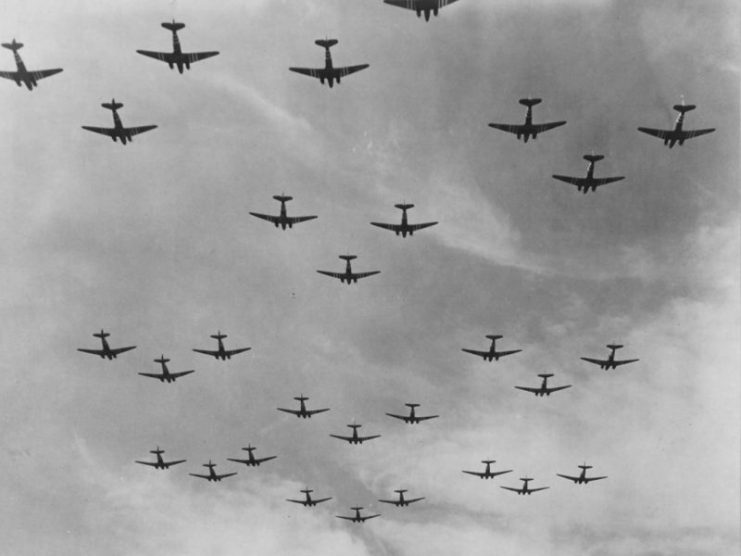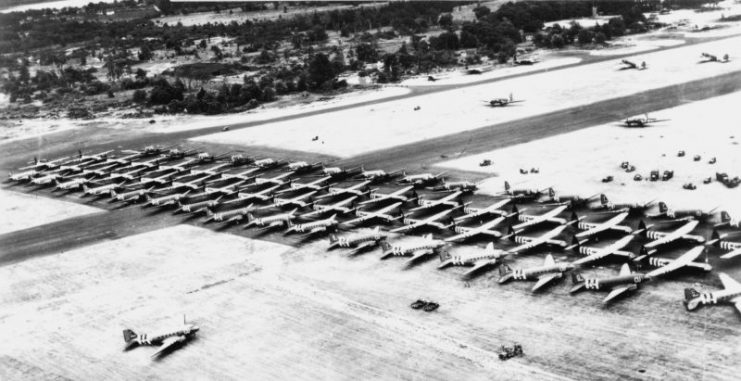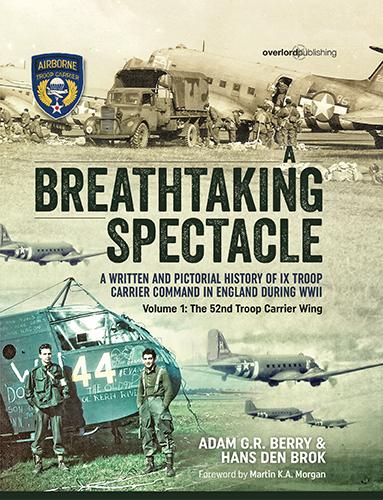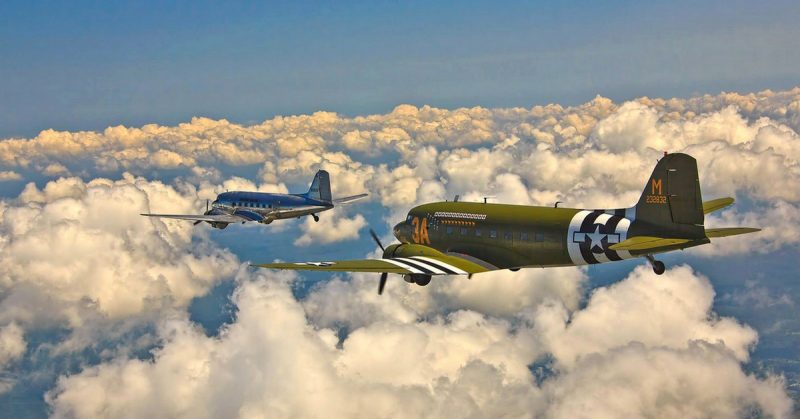In order to further decrease the risk of collision, many pilots pushed the throttle forward and climbed to a height above the clouds, anywhere between 1,300 and 2,500ft
As we approach the aviation event of 2019–this June’s mass flight of C47 Skytrains (Dakotas) over England and France–it is a fitting occasion to re-examine the role of the much-maligned C47 pilots in Operation Overlord.
Several mainstream authors have been damning in their criticism of the pilots, accusing them of being undertrained, underperforming, and even cowardly in some cases. A false impression has been given that these pilots’ nervousness resulted in the C47s flying too fast over the Cotentin Peninsula, making it difficult for the Paratroopers to make clean exits into the night sky.
According to this theory, excessive speed in combination with formation break-ups caused the poor drops made by the 82nd and 101st Airborne Division paratroopers. In the 75 years following D-Day, this assumption has been accepted as truth by many casual history buffs, and some of the surviving aircrews must have undoubtedly carried an undeserved burden of guilt.

It is now surely time for a more clinical appraisal, which Adam G.R. Berry fulfills in in his new book, A Breathtaking Spectacle.
As the aircraft approached the West coast of the Cotentin Peninsula on their run in to the drop zones, it is almost universally reported that a cloud bank was encountered in which visibility was effectively zero (in fact, 1st Lt Julian A Rice of the 316th Troop Carrier Group referred to this a “wall of fog”). A very quick glance at Group diaries and mission reports reveal that the cloud density, base and ceiling varied anywhere between 300ft and 2,500ft.
https://youtu.be/3coQ8Px2H8A
In maintaining a formation as densely packed as they were the night of D-Day, all but the lead pilots had to maintain a visual on the wing tip of the aircraft at the head of each flight. In fact, it was job of the Co-Pilot to maintain a visual directly ahead of the aircraft, allowing the pilot to stick to the wing tip of the aircraft to port or starboard and adjust accordingly, and they seldom ever looked directly out of the front windscreen of the aircraft.

This procedure is nothing short of impossible in zero visibility conditions, which is why under such circumstances troop carrier pilots were well rehearsed in fanning out the formations to avoid aerial collisions. This procedure was deemed necessary, meaning that so long as they were flying through this cloud bank, the formation was scattered and the pilots were unable to maintain sight of the other aircraft in the formation. They were effectively flying blind.
In order to further decrease the risk of collision, many pilots pushed the throttle forward and climbed to a height above the clouds, anywhere between 1,300 and 2,500ft.

Before the Drop Zone was approached the cloud dispersed slightly, though the 48th TCS report poor visibility over the DZ, allowing pilots to re-adjust, attempt to regain a tighter formation, but more importantly descend the aircraft back down to a height from which the paratroopers could jump, without gaining too much air-speed. In effect, what they had to achieve was akin to trying to keep a car at a certain speed down a steep hill without touching the brakes.
Pilots had to increase the drag of the aircraft by lowering flaps, or in extreme cases even the landing gear, as well as reducing the throttle to allow the aircraft to slow down whilst descending.
Pilots utilised a technique involving reducing the manifold pressure and revolutions to allow the propeller to spin freely in the wind. This created an airbrake effect, but also sounded as though throttle was being applied, which may explain why Paratroops report pilots increased throttle and airspeed on the approach to the DZ. In reality, they were clambering to slow the aircraft down.

A Breathtaking Spectacle – A Written and Pictorial History of IX Troop Carrier Command in England during WWII is written by Adam G.R. Berry and co-authored by Hans den Brok.
Adam is just one of the authors signing books at Daks Over Normandy this June.
Adam Berry Ttwitter
Daks Over Normandy – book-signing-sessions
Daks Over Normandy Facebook
